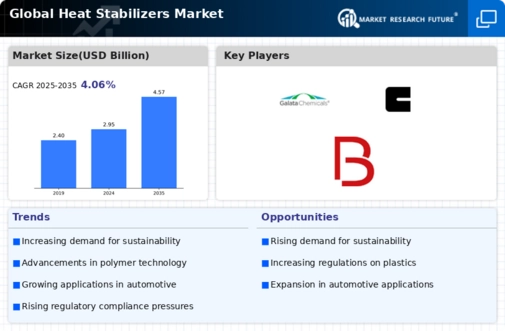Market Trends
Key Emerging Trends in the Heat Stabilizers Market
The Heat Stabilizers market exhibits several notable trends that significantly impact its growth, innovation, and competitive landscape. Understanding these trends is crucial for stakeholders to adapt and capitalize on emerging opportunities within the industry.
One prominent trend in the Heat Stabilizers market is the increasing emphasis on sustainability and eco-friendliness. With growing environmental concerns, there's a rising demand for stabilizers that are free from harmful components like heavy metals. Manufacturers are investing in research and development to create eco-friendly alternatives that meet stringent regulatory standards while delivering optimal performance. This trend aligns with consumer preferences for greener products and encourages companies to develop and promote environmentally responsible stabilizers.
Another notable trend is the shift towards high-performance and specialized formulations. Industries such as automotive, construction, and electronics demand Heat Stabilizers that offer enhanced heat resistance, durability, and performance. Manufacturers are focusing on developing specialized formulations tailored to meet these specific industry needs. This trend drives innovation in product development, encouraging companies to create stabilizers with superior properties to cater to diverse industrial applications.
The adoption of bio-based or renewable sources in Heat Stabilizers is gaining traction as a sustainable alternative. Companies are exploring the use of bio-derived materials or renewable resources in manufacturing stabilizers. This trend aligns with the global push towards reducing dependence on fossil fuels and minimizing the environmental impact of industrial processes. The development of bio-based Heat Stabilizers not only addresses environmental concerns but also taps into the growing market demand for sustainable solutions.
Technological advancements continue to shape market trends in the Heat Stabilizers industry. Innovations in manufacturing processes, such as nanotechnology and advanced polymer chemistry, enable the production of stabilizers with improved performance and efficiency. These technological advancements drive the development of next-generation stabilizers that offer better heat resistance, weatherability, and overall performance, meeting the evolving demands of various industries.
Market consolidation and strategic partnerships are prevalent trends within the Heat Stabilizers sector. Companies are engaging in mergers, acquisitions, and collaborations to expand their product portfolios, access new technologies, and strengthen their market positions. Strategic alliances allow firms to combine resources, expertise, and R&D capabilities to innovate and compete more effectively in the market.
The growing demand from emerging markets is another significant trend in the Heat Stabilizers industry. Rapid industrialization, urbanization, and infrastructural development in regions like Asia-Pacific and Latin America are driving the demand for Heat Stabilizers. Manufacturers are focusing on expanding their presence in these markets by tailoring products to local needs and preferences, thereby capitalizing on the burgeoning opportunities.
Additionally, the trend of customization and flexibility in product offerings is gaining prominence. Companies are increasingly offering customizable stabilizer solutions to meet specific customer requirements. Customization allows industries to access tailor-made stabilizers that address their unique challenges, leading to increased customer satisfaction and loyalty.







Leave a Comment